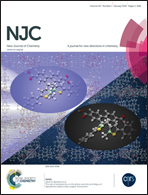Selective basic etching of bifunctional core–shell composite particles for the fabrication of organic functionalized hollow mesoporous silica nanospheres†
Abstract
Hollow mesoporous silica nanospheres with high-density functional groups were successfully prepared based on an effective basic selective etching strategy. In this work, thiol-functionalized hollow mesoporous silica nanospheres were synthesized by the etching of cyano-SiO2@thiol-SiO2 and vinyl-SiO2@thiol-SiO2 core–shell composite particles. The composite particles were fabricated, respectively, via a two-step sol–gel reaction of different organosilanes. The different alkali resistance between the inner core and the outer shell of the composite particles is the key to fabricating hollow silica nanospheres in this paper. When the core–shell composite particles were treated with Na2CO3 and NaOH, the thiol functionalized outer shell showed higher stability than the cyano and vinyl functionalized inner core. The inner core, which is less stable under alkaline conditions, will be etched off in base, resulting in a hollow structure. Transmission electron microscopy (TEM) results demonstrate that large-scale hollow mesoporous silica nanospheres can be obtained through this method. In addition, it is also found that the morphology of samples may be regularly changed by manipulating the concentration of alkali in the etching process. Fourier transform infrared (FT-IR) and energy dispersive spectrometry (EDS) confirm that the thiol groups exist in the organic functionalized hollow mesoporous silica nanospheres obtained. We expect that this facile strategy can be extended to fabricate organic functionalized hollow mesoporous silica nanospheres with more other valuable functional groups.



 Please wait while we load your content...
Please wait while we load your content...